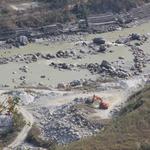River sand mining as a livelihood activity: The case of Nepal
This paper investigates the livelihood dimension of small-scale river sand mining. To what extent is low intensity, so called artisanal, sand mining an important livelihood activity among poor people who live along small rivers where people shovel sand by hand onto small tractors during the dry season? Even at the foot of the Himalayas, river sand mining is not a wide-spread activity. A core contribution of the paper is to identify sand worker settlements along two smaller rivers in the eastern plains of Nepal. All household livelihood activities were registered and compared to a random sample of households from neighboring villages. Sand workers have less land than the population at large, although they can be landowners and combine sand mining with own farming and daily labor both in agriculture and elsewhere. Sand workers earn about the same as other low-skilled laborers; however, a major benefit is more regular income than other forms of low-skilled labor such as agriculture or construction work. The data further suggests that sand work is an alternative to labor migration, which normally gives higher income, but at the cost of being away from the family for months or even years.
https://doi.org/10.1016/j.exis.2023.101266
Magnus Hatlebakk

The political economy of river sand mining in South Asia





